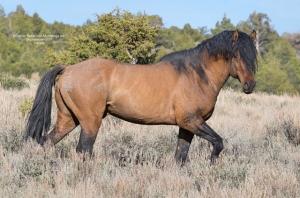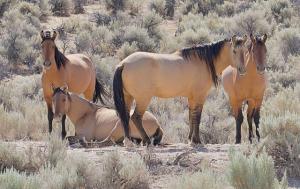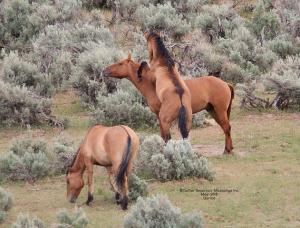Rare Wild Horses in N. California Confirmed To Have Spanish-Iberian Bloodlines

Carter Reservoir stallion, Freedom, may be the most well-known of the Carter wild stallions having even inspired a painting.
Science proved the BLM-managed Carter Reservoir Mustangs are Spanish-Iberian horses requiring conservation. CRMI urges support “Stand With The Carters” Petition
Our finding clearly indicates a Spanish origin of the ancestors of the mustangs living in the Carter Reservoir”
RICHLAND, OREGON, UNITED STATES, January 13, 2022 /EINPresswire.com/ -- The unique Carter Reservoir Mustangs’ home on the range is located in Modoc County in northeast California and northwest Nevada within Washoe County on Bureau of Land Management (BLM) public land. The herd is managed by California BLM. — Certagen Labs - Germany
Knowing the herd was special and had observable Spanish physical characteristics and coloring (phenotype), the volunteer-driven non-profit, Carter Reservoir Mustangs, Inc. (‘CRMI’) was founded by Darice Massey in 2015 in order to intensively document, photograph, and obtain hair samples to scientifically prove the herd’s ancestral heritage through genotyping. This research forms the basis of CRMI’s mission: to protect and conserve the genetic, cultural, and historic significance of America’s endangered Carter Reservoir Mustang Herd, one of the rarest and most unique mustang herds still living in the wild today. They either directly trace back 500+ years to those horses brought to North America by the early Spanish explorers or their ancestors that escaped the extinction event in N. America about 10,000 years ago and survived as an isolated distinct population segment (a possibility revealed by a brand new study noted later).
Incredibly, 31 out of 31 Carter hair samples that were sequenced using mitochondrial DNA (mtDNA) and analyzed by Certagen Labs in Germany conclusively prove the herd is of Spanish-Iberian ancestry based on the maternal side. Certagen stated: "Our finding clearly indicates a Spanish origin of the ancestors of the mustangs living in the Carter Reservoir." [1]
All of the 31 Carter samples provided to Certagen fall into one of two clusters: 29 samples match Cluster D1, dominated by Iberian and North African horses; and two samples match Cluster D3, most characteristic for Dulmener from Mid and Southern Europe, American Mustang, and Andalusian. Those horses matching either the D1 or D3 clusters trace back to the D Supercluster representing the Iberian Horse population and are verifiably of Iberian descent. Because of these test results, the majority of the Carter Herd may well have the highest percentage of individuals with ancient Spanish-Iberian DNA of any U.S. wild herd tested to date, identifying the Carters as an irreplaceable Heritage Herd and Genetic Resource. Importantly, the D genotype is the oldest of known wild types dating back an estimated 500,000 years ago. [2,3]
The reason for the herd's rarity is that it is quite isolated from intermixing with other wild herds or with domestic stock. The downside of this isolation is the possibility of inbreeding and genetic bottlenecking, which needs close monitoring. The majority of the herd exhibits stunning primitive “super dun factor” phenotype markings: large shoulder capes, bars, and smudges; dorsal stripes; herringbone stripes; ventral stripes; zebra stripes on the hocks and knees; armbands; outlined, dipped, and striped ears; multicolored manes and tails; cobwebbing on the forehead; and face masks on dun body colors that range from light cream to dark honey with black points, light to dark solid reds, together with some grullos (mouse grays). The remaining herd colors are bay, palomino, and chestnut. These solid colors increase the expression of the dominant super dun factor coloration.
Because Darice and the team know the Carter Mustangs probably better than anyone else from hundreds of hours of documentation and over 100,000 photos captured, CRMI can help with planning, protection, and conservation of the herd both on and off the range. A large roundup of the herd is inevitable in the near future by California BLM. In fact, BLM recently announced a bait and trap removal of up to 25 Carters deemed “nuisance” horses by a couple of private property owners and because of road safety concerns.
With seven years worth of detailed records, CRMI can support California BLM with scientific data on which bands and individuals should be removed, which should remain in the wild, and which are good candidates for sanctuary to conserve the ancestral genetic lineage. This knowledge will benefit the continued genetic health and integrity of the herd both on and off the range and will help avoid any of them indirectly going to brutal slaughter in Canada and Mexico.
Of course, the ideal scenario would be for the small Carter Reservoir Herd Management Area (HMA) range of about 24,000 acres to be expanded in size to include some of their original historic range (over 300,000 acres) in order to support a healthy, genetically viable herd of at least 200 Carters in the wild long term. Also, classifying the expanded HMA as the "Carter Reservoir Spanish-Iberian Wild Horse Range," instead of HMA, would guarantee the herd is managed "principally" over other uses on their homeland which would, in turn, ensure their long-term conservation. These changes would follow Dr. Sponenberg's recommendations in his report to BLM 20 years ago where he characterizes the few wild Spanish herds in the U.S. as "genetic resources that are unique and irreplaceable" and "the management for those few herds should be tailored to accommodate conservation of the genetic resource as a fundamental goal." [4]
All the wild herds in America are special, but the Carter Reservoir HMA Wild Horses deserve official special status designation as a Spanish-Iberian Heritage Herd and Genetic Resource because of their proven rare bloodlines, and cultural and historical significance to America, California, and maybe even to Spain and the world.
The horse is native to N. America, beginning its evolution over 50 million years ago. The new study mentioned earlier has established that some N. American wild horses actually survived the last Ice Age. [5]
Dr. Ross MacPhee of the American Museum of Natural History states, “The horse that lived in the Yukon 5,000 years ago is directly related to the horse species we have today, Equus caballus. Biologically, this makes the horse a native North American mammal, and it should be treated as such.” The wild native Carters embody remnants of this ancient evolution, thus why their protection and conservation are of utmost importance.
America’s wild herds, including the unique Carters, and the public lands are owned by all of the American people. Please show your support for your legacy and for the stepped-up protection and conservation of the Carter Reservoir Spanish-Iberian Mustang Heritage Herd by signing CRMI’s “Stand for the Carters” Petition at this link:
https://www.carterreservoirmustangs.org/petition
“It’s an honor and privilege to volunteer on behalf of the protection and conservation of the unique Carter Reservoir Mustangs living free with their families on public lands under BLM jurisdiction. Being amongst their presence in the wild has been awe-inspiring and continues to fuel my passion and vision to help their unique magnificence thrive and to share their message far and wide", said Darice Massey, Founder/President, Carter Reservoir Mustangs, Inc.
More information: https://www.carterreservoirmustangs.org/
Contact: info@carterreservoirmustangs.org
[1] Certagen Lab Test Result Letters to CRMI dated November 23, 2015, and September 21, 2020
[2] Oelke, Hardy, “Phylogenetic Network Charts,” derived from Jansen, et al. (at Footnote 3), http://www.sorraia.org/Just_another_breed.html
[3] Jansen, et al., “Mitochondrial DNA and the origins of the domestic horse,” PNAS, August 6, 2002, https://www.pnas.org/content/99/16/10905
[4] Sponenberg, D. P., “Deciding Which Feral Horse Populations Qualify as a Genetic Resource,” BLM Wild Horse and Burro Program, Resource Notes, No. 25, July 19, 2000
[5] Murchie, T. J., et al, “Collapse of the mammoth-steppe in Central Yukon as revealed by ancient environmental DNA,” Nature Communications, published online December 12, 2021, https://tinyurl.com/mw76menj
#WildHorses #Mustangs #CarterWildHorses #CarterMustangs #CaliforniaWildMustangHerd #SpanishIberian #CarterReservoirMustangs #CarterWOWfactor
Darice Massey
Carter Reservoir Mustangs, Inc.
+1 530-710-2865
info@carterreservoirmustangs.org
Visit us on social media:
Facebook
LinkedIn
Other




